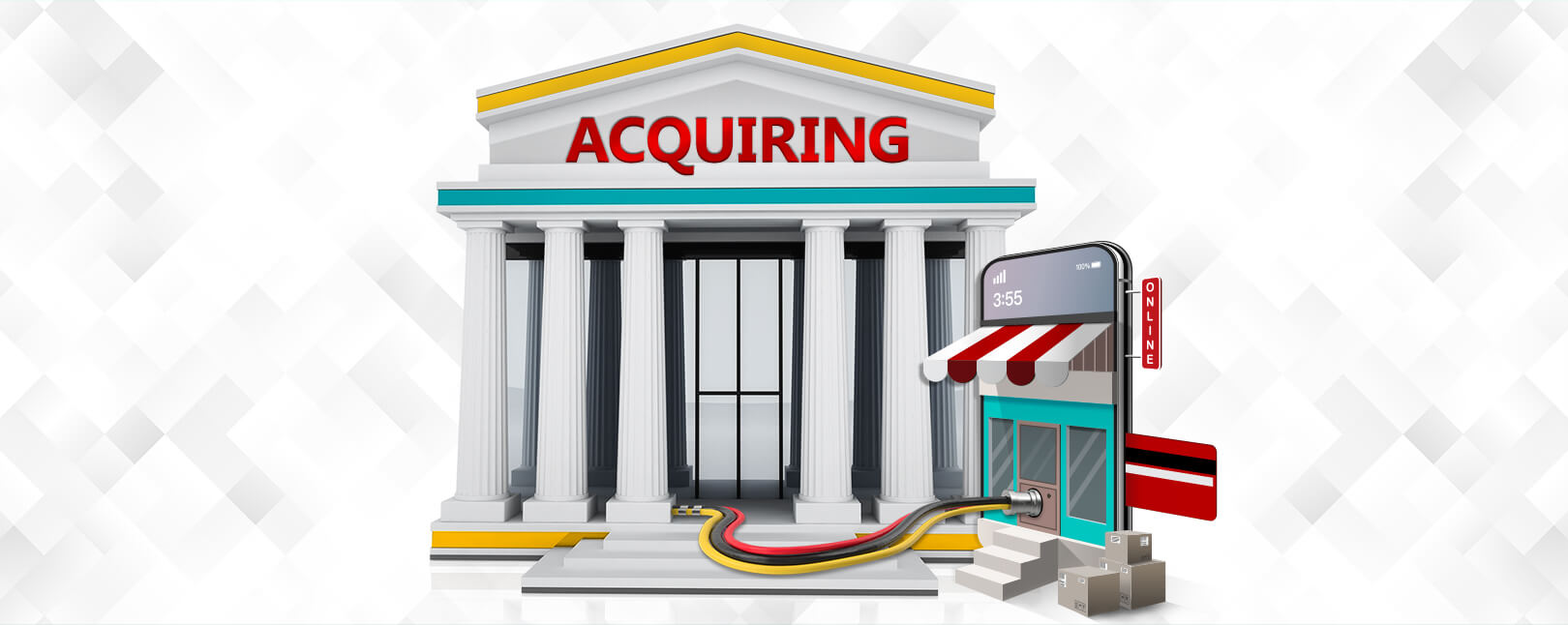Acquiring Bank Services: Your Handbook for Merchants
As we discussed in a recent article, issuing banks work directly with cardholders to issue cards and facilitate transactions. Acquiring banks, in turn, provide the financial backing and infrastructure necessary for merchants to accept payments from those credit cards. They also assume much of the financial risk involved with credit card purchases, responsibility for securing the flow of data, and initial liability in the event of a dispute.
Despite its importance, many merchants remain a bit confused about the role of their acquiring bank in the payment process. Today, let’s take a moment to clear up some confusion on that topic.
Recommended reading
- 7 Common Reasons Why Issuer Declines Happen
- Merchant Identification Number: How to Find Your Merchant ID
- My Bank Account is Under Investigation? What’s Going On?!
- VAR Sheets: Get All Your Documents Ready in 4 Basic Steps
- Internet Processing: Understanding the eCommerce Process
- Issuer vs Acquirer: What’s the Difference?
What is an Acquiring Bank?
- Acquiring Bank
An acquiring bank is a financial institution that accepts and processes credit and debit card transactions on behalf of merchants. Sometimes referred to as an “acquiring bank” or "merchant bank."
[noun]/ə · kwī · riNG · baNGk/An acquiring bank (the “acquirer”) serves as the middleman in payment card transactions. They link merchants with issuing banks (the “issuer”), which issue credit and debit cards to consumers, thereby allowing them accept card payments. This is done via a card network (don’t worry — we’ll delve into all these terms below in a little more detail).
Acquiring banks are not consumer-facing “banks” in the sense of having branches with drive-up windows and ATMs. Rather, they are the middleman for all credit card processing involving a merchant. Payment card transactions — including purchases, refunds, chargebacks, and more — involve more players than just the cardholder and the merchant. Between the two, there will always be an acquirer.
The banks also assume much of the financial risk involved with credit card purchases. They’re also responsible for securing the flow of data, and hold initial liability in the event of a dispute.
The Acquirer’s Role in the Transaction Process
An acquirer is crucial to have a successful card transaction. Without a bank, there would be no account to which the cardholder’s bank could route the funds for a transaction. The merchant would not be able to accept card payments at all.
Acquirers play a vital role in every transaction, but they don’t work in a vacuum. In fact, there is a complex process going on behind the scenes of every card swipe involving multiple parties. In the next few sections, we’ll explore how these institutions interact and contrast with these parties.
Besides the bank, some of the other key players include:
The Merchant
Commercial payment card acceptance point, where credit/debit cards can be used to purchase goods or services.
The Issuing Bank
Issues credit cards to consumers. This bank represents customers and card networks and is not a merchant-facing bank.
The Payment Processor
Submits bankcard transaction information to the card network, where it can be routed to other parties as necessary.
The Card Network
The Card Network Also called an association or network. Licenses and oversees their credit card brand and defines the parameters of use and processing.
There are other third-party service providers as well, supplying services like web hosting, SSL certificates, shopping carts, payment gateway services, and more. And, of course, there is the actual cardholder who uses a payment card to purchase goods or services.
On that note, these roles tend to be a little confusing to merchants and consumers, particularly with regard to the difference between the acquiring bank and payment processor. These are not the same thing, though, as we’ll clarify further in the next sections.
Acquiring Banks vs. Issuing Banks
The main difference between issuing and acquiring banks lies in who they represent. Acquiring banks represent merchants, while issuing banks represent cardholders.
To flash these differences out, the following table highlights each bank’s responsibilities in greater detail:
Acquiring Bank
- Maintains rules and requirements for merchant accounts
- Maintains and manages merchant accounts
- Oversees account activity (deposits, withdrawals, and fees)
- Communicates with approved payment processor
- Requests authorization for transactions from approved payment processor
- Deposits transaction funds into merchant accounts
- Receives dispute notices and debits merchant accounts
- Receives, reviews, and forwards merchants chargeback responses
Issuing Bank
- Processes credit and debit card applications
- Provides and maintains credit and debit card accounts
- Issues payment cards to consumers
- Approves or declines consumer credit and debit card transactions
- Releases funds to acquiring banks upon transaction approval
- Facilitates credit and debit card transactions
- Files dispute and chargebacks on their cardholder’s behalf
- Reviews dispute responses and assigns liability
Is a Processor the Same as an Acquirer?
The short answer is “no.”
Acquiring banks are named for the function they perform in credit card processing. These banks accept credit card transactions from issuing banks, then process those transactions for their merchant customers. This is why the roles of banks and payment processor are often confused.
Acquiring banks may sometimes be described as having “processed” a transaction. And, there are several companies who provide both payment processing and banking services to clients. But, while the terms “acquirer” and “payment processor” are often used interchangeably, they refer to two fundamentally different functions:
Acquiring Bank: The financial institution that underwrites and processes payment card transactions.
Payment Processor: A company that facilitates communication between the merchant and the cardholder's bank.
Acquiring Bank
- Intermediates between merchants and issuers
- Maintains merchant accounts
- Accepts or declines transactions on a merchant’s behalf
- Extends line of credit to merchant
- Deposits funds into merchant account
- Negotiates disputes on merchant’s behalf
Payment Processor
- Processes transactions between credit card companies and merchants
- Verifies consumer transactions
- Intermediates between issuing banks and acquirers
- Approves or denies transactions
- Facilitates funds transfer
- Secures transactions
A payment processor acts as an intermediary, securing payment data and making sure transactions comply with security standards. These companies do a lot of the legwork such as verifying card details, facilitating transfers, passing information back and forth between parties, and keeping that information secure in the process.
In contrast, the acquiring bank maintains its customers’ merchant accounts. This is an open line of credit, allowing the bank to accept transactions and deposit funds on behalf of each business it works with. Think of a merchant account as a virtual bank account linked to a physical bank account used to process payment cards. The bank takes transactions that are approved by the payment processor and settles the relevant accounts.
Learn more about payment processorsWhy are Acquiring Banks Necessary?
Payment processors do much of the actual processing of payment card transactions. So, if payment processors are handling the workload, what do acquiring banks bring to the table? Financial backing, for one thing.
Processors are not banks; they’re limited in the services they can provide. Ultimately, merchants need someone to extend credit and receive payments (i.e. the acquirer). Acquirers provide the funds that allow for the timely settlement of payment card transactions. It’s comparable to extending a loan to the merchant until the card transaction can be settled.
Obviously, there’s a certain amount of risk involved with that. Acquiring banks assume the responsibility for transactions processed on behalf of their merchants. And, since merchant accounts are considered lines of credit (as opposed to holding accounts), banks also take on the inherent risk associated with the transactions they process.
For example, let's say a business goes bankrupt and is unable to pay out customer refunds, disputed transactions, or bank chargebacks. That merchant’s acquiring bank must accept those liabilities and provide funds to settle all accounts. They can try to recover their funds from the merchant later, but if the merchant goes bankrupt, then the institution may end up eating those losses.
That explains why businesses with the most risk have the fewest options when it comes to acquirers. It also explains why the options available to high-risk merchants will be costlier and have more restrictions.
Leading Acquiring Banks (And Their Fees)
There are dozens of merchant-facing acquiring banks in the US that accept transactions from American Express, Discover, JCB, Mastercard, and Visa. These banks also settle transactions for payment facilitators and aggregators like Block, Clover, PayPal, and Square, besides countless independent sales organizations (ISOs).
Every acquirer charges a series of fees, sometimes referred to as a merchant discount rate. These merchant service fees are typically a percentage per volume of transactions.
To illustrate this concept, the top 10 acquiring bank examples active in the US and their merchant service fees include:
| Acquiring Bank | Annual Transaction Volume (Approx). | Merchant Account Fees |
| Fiserv | 100 billion | *Pass-through plus interchange; no data |
| WorldPay From FIS | 75 billion | Discount rates and per-transaction fees for Visa, Mastercard, and Discover will be assessed an additional 0.0966% and $0.045 per transaction. Transaction Risk Fee for non-qualified, mid-qualified, and high-risk rates will be assessed an additional 0.15%. |
| Global Payments | 50 billion | Flat-rate plus interchange; 2.9% + $0.29 per transaction |
| JP Morgan Chase | 31 billion | $1.80 interchange fee 90% of total fee. Assessed by the payment network to cover the risk and cost of a card transaction. 7% $0.14 network (switch) fee 7% of total fee. Assessed by the payment network for its use. 3% $0.06 processor fee 3% of total fee. Assessed by a merchant services provider for authorization, settlement, chargebacks, reporting, and customer service |
| Wells Fargo | 7.7 billion | 3.1% plus 15 cents and up for online transactions; 2.2% plus 15 cents and up for in-person transactions; 3.1% plus 15 cents and up for manually keyed transactions; 2.4% plus 20 cents and up for in-person B2B transactions; 3.5% plus 20 cents and up for online or manually keyed B2B transactions |
| Bank of America | 8.7 billion | 2.65% + $0.10 per swiped, dipped, or tapped transaction (card-present) 2.99% + $0.30 per eCommerce transaction. 3.50% + $0.10 per keyed-in/virtual terminal transaction |
| Merrick Bank | 6 billion | Swiped Rate 2.5% + $0.20, 3.5% + $0.20, $75.20 Per Year ($18.80 charged each quarter), Equipment Lease Terms 48 Month (locked), Early Termination Fee 1% of Gross Volume |
| Elavon | 5 billion | 0.16% + $0.25 per transaction. $0.25 per transaction authorization. 0.60% per international transaction. $0.40 per settled batch |
| Paysafe | N/A (~$120 billion each year) | 2.9% plus 30 cents for online transactions or invoices without a card on file (2.6% plus 30 cents with Premium plan) |
| North American Bancard | N/A (~$45 billion each year) | Flat-rate plus interchange; 0.29 percent per transaction |
As you may have noted, many of the banks above charge a lot more than just one fee. The reason for this is because, as we mentioned above, acquiring banks assume a significant amount of risk on their merchants’ behalf. But, even with those added fees, a bank may still determine that a merchant is too risky to work with.
Can Merchants Be “Fired” By an Acquirer?
In short: yes.
As mentioned in the previous section, acquirers accept the risk that merchants will not remain in business and be able to pay their bills. They also accept the risk of funds reversals, in the form of payment disputes and chargebacks, on merchants’ behalf as well.
Most of the merchants reading this are well aware of chargebacks and their associated headaches. So, it should come as no surprise that some acquirers might be keen to limit their outgoing expenses and risk of fraud by limiting problematic merchant accounts. After all, any business on the hook for losses that the business didn’t incur can be expected to attempt to limit its risk as much as possible. That includes by association.
Merchants that consistently breach the fraud or chargeback threshold of more than 1% of their incoming transactions will experience fines and penalties for each instance thereafter. Most often, when a merchant is in danger of breaching this threshold, their acquirer will automatically shift their merchant account into a merchant reconciliation program.
These programs are designed to encourage merchants to lower their fraud rate and/or their chargeback rate to acceptable levels within a limited timeframe. If the merchant fails to meet this benchmark, and they continue to receive a high number of chargebacks, they may have their merchant account terminated altogether. They would then be placed on the MATCH List, and blacklisted by other acquirers.
Acquiring banks face a high amount of risk, and also hold a key position in the payment chain. As such, transaction security is a great concern for these institutions. If a merchant gets “fired” by their bank… they may be forced to seek alternative processing to take credit and debit card payments.
Protecting Your Merchant Account
A merchant’s foremost priority should be to keep fraud and chargeback issuances below the thresholds set by the card networks. While there is certainly no way to entirely prevent either from happening, it is possible to dramatically reduce risk and increase revenue without switching acquirers.
A few best practices that could help protect your merchant account include:
FAQs
What is an acquiring bank?
An acquiring bank is a financial institution that accepts and processes credit and debit card transactions on behalf of merchants. Sometimes referred to as an “acquiring bank” or "merchant bank."
What is the function of an acquiring bank?
An acquiring bank (acquirer) serves a key role in payment card transactions. They link merchants with issuing banks (those that issue credit and debit cards to consumers), and facilitate payments between parties.
What is the difference between a card issuer and acquirer?
While issuing banks work directly with cardholders, acquiring banks provide the financial backing and infrastructure for merchants to accept credit cards. They also assume much of the financial risk involved with credit card purchases, responsibility for securing the flow of data, and initial liability in the event of a dispute.
What is the difference between a payment processor and acquirer?
A payment processor acts as the intermediary, securing payment data and making sure transactions comply with security standards. These companies do a lot of the legwork such as verifying card details, facilitating transfers, passing information back and forth between parties, and keeping that information secure in the process.
The acquiring bank, in contrast, maintains its customers’ merchant accounts. This is an open line of credit, allowing the bank to accept transactions and deposit funds on behalf of each business it works with.
Why are acquiring banks necessary?
Processors are not banks; they’re limited in the services they can provide. Some acquirers may offer payment processing solutions, and many larger ones do. Ultimately, though, merchants need someone to facilitate payments (the processor), and someone to extend credit and receive payments (the acquirer). Acquirers provide the funds that allow for the timely settlement of payment card transactions. It’s comparable to extending a loan to the merchant or PSP until the card transaction can be settled.














